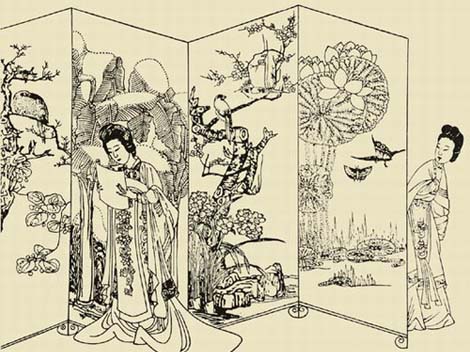
The division of roles in Zaju of the Yuan dynasty is quite different from that in Zaju of the Song dynasty and performers' scripts of the Jin dynasty. The principal characters in a play are called "zheng se". The hero is called "zheng mo", and the heroine "zheng dan". Besides mo (role of middle-aged man in classical opera) and dan (female character type in Chinese opera), there are fu mo (deputy mo), tie dan (deputy dan), jing (actor with a painted face), gu (official) and bu er (old women), etc. In Zaju, only major roles have librettos. "Mo ben" is the term for the libretto of zheng mo, and "Dan ben" is the term for the libretto of zheng dan. Other roles have actions and spoken parts, but no libretto.
Lyrics are the main part of Zaju of the Yuan dynasty, and the core of lyrics is libretto. A zhe is made up of a suite of music of the same gong diao, and the same rhyme goes through the zhe. Four zhes can use four different gong diaos. Each gong diao has its own tonality and the gong diaos in the four zhes change with the development of the plot. Besides lyrics, binbai (spoken parts in the play) and kefan (stage instructions for acts, expressions and effects during the performance) are also major constituent elements of zaju.
Sanqu, as opposed to juqu, was lyrics popular during the Jin and Yuan dynasties and a new poetic style rising after poem and ci. In the literary world of the Yuan dynasty, it was equal to traditional poem and ci forms, and represented the highest merits of poetic creation of that time. Qu evolved from ci. By the Yuan dynasty, ci had been completely independent from music and became pure literary creation.
Sanqu includes two types, namely xiaoling and taoshu. Xiaoling is made up of a single piece of music. The lines are not uniform in length, but have certain format. Taoshu (divertimento), also called "santao", comprises over two pieces of music of the same gong diao. It is similar to taoqu in Zaju. Sanqu is very different with poem and ci in metrical pattern and style. Some sanqu works are elegant and graceful, and some bold and incisive. Elegance, forthrightness, pungency, humorousness and coarseness are characters of qu different from that of poem and ci, and the inherent qualities of qu. In the early Yuan dynasty when sanqu had just risen and had not become a major genre in the poetic circles, writers of sanqu were mostly dramatists or poets, such as Guan Hanqing, Baipu, Ma Zhiyuan, Lu Zhi, Yao Sui and Feng Zizhen. Among them, the works of Feng Zhiyuan and Lu Zhi were the largest in number and more influential. By the late Yuan dynasty, sanqu had become a major genre in the poetic circles and specialty of many literati. A number of sanqu writers appeared, such as Zhang Kejiu, Qiao Ji, Zhang Yanghao, Sui Jingchen, Liu Shizhong, Guan Yunshi and Xu Zaisi.
We Recommend
